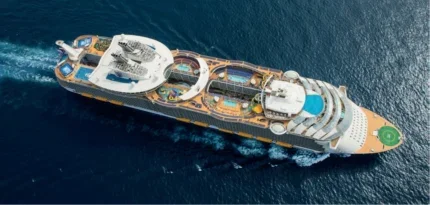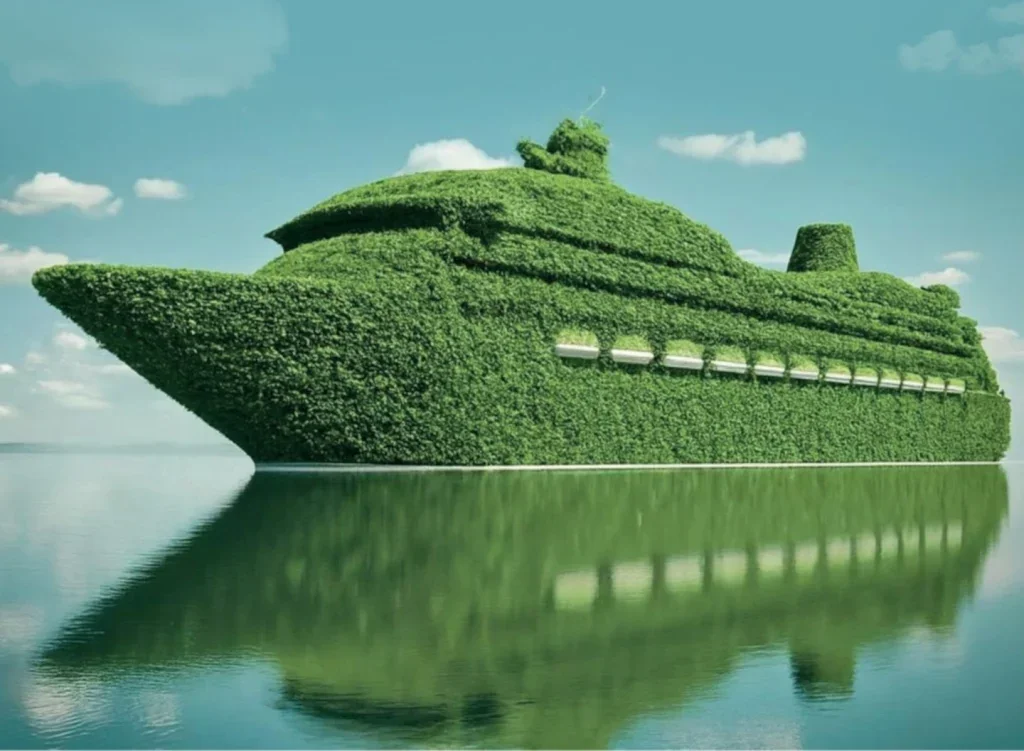
This year marks the start of a long-term biofuels test by Holland America Line (HAL), which could play a major role in tipping the scales towards wider adoption across the cruise industry. The operator’s flagship vessel, Rotterdam, will be using 100% low carbon intensity biofuel as it ploughs the waters of the Norwegian World Heritage Fjords – the Geirangerfjord and the Nærøyfjord.
In such areas of outstanding natural beauty, it is vital to reduce or eliminate any environmental pollution. In fact, back in 2022, the country’s Ministry of Climate and Environment tasked the Norwegian Maritime Authority (NMA) to come up with plans to achieve zero emissions from cruise ships, tourist boats and ferries in these World Heritage Sites and the surrounding fjords by 2026 at the latest. HAL hopes that its trial using the GoodFuels MR1-100 sustainable biofuel, supplied by FincoEnergies, will be a stepping stone towards this goal.
The chosen fuel is expected to yield an estimated 86% reduction in life-cycle greenhouse gas emissions. GoodFuels’ sustainable biofuels are virtually free of sulphur oxides, as well as delivering 80–90% well-to-exhaust CO2 reduction compared to fossil fuel equivalents.
Back in April, Rotterdam bunkered the sustainable biofuel, which is certified according to the EU Renewable Energy Directive, before departing from its home port, with Gus Antorcha, president of HAL, remarking that the company was “committed to reducing our greenhouse gas emissions and we are excited to demonstrate a next-generation fuel source that can help us toward our pursuit of net zero emissions”.
Initial tests took place in May using one of the ship’s four engines, with the scope to expand the use of biofuel to more engines during cruise operations over the summer. The company noted that operating on biofuels required no modifications to the engine or fuel structure. During testing, HAL will continue to partner with other companies to explore other ways to reduce emissions, which will include the further development and testing of alternative fuels, as well as other technologies.
“The GoodFuels MR1-100 fits the existing practice in shipping where heavier fuels are already used today,” remarks Johannes Schurmann, commercial director, international marine, at fuel supplier FincoEnergies. “[It can] optimise sustainability and cost of the biofuel, while not jeopardising the performance in the engine and fuel system.”
Biofuels promise more than emissions reductions
The appeal of biofuels for the cruise sector – and other industries – does not derive solely from their huge impact on efforts to reduce greenhouse gas emissions. They contribute to the sustainability agenda in a much broader way.
Biofuels are derived from feedstocks that are certified to be 100% organic waste or residue. This means that they not only offer a promising solution for reducing emissions when burnt, but do so without competing with food production or contributing to deforestation. They are made using leftover waste fats, oils and grease, and the production process itself generates minimal emissions.
The result is fuels with far lower carbon intensity ratings than conventional marine gas oil (MGO), and which can run on unmodified engines. “There is a need to look at all good alternatives to reduce greenhouse gas emissions in the future and we see biofuels as one of the alternatives that, with the right use and origin, will contribute to emission reductions, which we welcome,” explains Alf Tore, acting director, general of shipping and navigation, for the Norwegian Maritime Authority trial.
The full exercise in using biofuels did not come out of the blue. HAL has already completed an initial test in the summer of 2022, but its latest foray into the world of alternative fuels is first longterm trial conducted among Carnival Corporation brands to include periods of running exclusively on 100% biofuels during routine ship operations.
Previously, biofuels had been extensively tested using large diesel engines at onshore research facilities, or in other segments of the shipping sector, so the live tests conducted aboard operational cruise vessels are a major step forward for the industry. It could lay the foundation for wider industrial use of fuels that are essentially converted food waste.
Fortunately, global biodiesel supplies are rising to record highs at the moment, which may go some way toward allaying fears that supply might not be able to keep pace with demand due the potentially high usage in shipping if the trials are successful. The growth in supply is partly due to increased production of soybean meal in the US and South America, and the International Grains Council (IGC) currently estimates that global biodiesel production – including hydrotreated vegetable oil (HVO) – hit at a record high of 71.5 million tonnes in 2023, some 11% higher than in 2022.
The European Union remains the world’s biggest producer of biodiesel, though the most significant growth in production is occurring elsewhere, notably Asia, in addition to the US and South America. The IGC expects total global output to reach 76.3 million tonnes in 2024. In the US alone, production of biodiesel and HVO has practically doubled to almost 20 million tonnes since 2020, and could reach 21 million tonnes this year.
Industry-wide interest
HAL is not alone in exploring the potential of biofuels. Indeed, there is interest across the cruise industry. Royal Caribbean has conducted its own trials as part of its Sea of the Future initiative, which is looking at a host of innovations from bow to stern to deliver more efficient vessels and help the industry move towards net-zero emissions by 2050.

In late 2022, Royal Caribbean began to expand the testing of biofuel use on its older ships to assess the impact on the line’s decarbonisation efforts. That year, the 20-year-old Navigator of the Seas sailed for three nights from Los Angeles to Ensenada, Mexico, using one engine powered by biodiesel. Once again, the ability to use biofuel with existing engines was a major catalyst for the trial.
The biodiesel for that test was supplied by World Fuel Service, which created it using animal fat and corn, as well as waste vegetable and frying oils. The success of the three-month trial prompted the operator to expand biofuel use to two engines initially, with the aim of running an entire ship on biodiesel, which is molecularly identical to diesel.
“Following our successful trial of biofuels, we are one step closer to bringing our vision for net-zero cruising to life,” commented Jason Liberty, president and CEO of Royal Caribbean Group, as the line completed more than 12 consecutive weeks of biofuel testing in Europe in 2023.
“As we strive to protect and promote the vibrant oceans we sail, we are determined to accelerate innovation and improve how we deliver vacation experiences responsibly,” he added. “This is a pivotal moment for Royal Caribbean Group’s alternative fuel journey.”
Also in 2023, Ponant’s Le Champlain bunkered with biodiesel B100 made from recycled cooking oil. The Explorer-class vessel is part of the company’s long-term plan to use biofuels across its entire fleet. The ship’s Wartsila diesel engines can use B100 as a fully compatible drop-in fuel without any modifications.

“This first marine biofuel test is part of our roadmap as their carbon footprint is infinitely lower than conventional fuels, with a 90% reduction of CO2 emissions,” remarked Ponant’s newbuilding and R&D director Mathieu Petiteau at the time. “They are produced from used cooking oils, can be incorporated directly into engines, and are available now. We want to help demonstrate that it is a credible alternative that can contribute to decarbonising our fleet and the entire maritime industry.”
Simple yet complex
The compatibility of biofuels is a major boon and makes the transition seem simple, but there are many challenges to overcome. Ponant reported that during its trial it found biodiesel bunkering to be more complex than it had initially expected. Petiteau noted that going beyond 30% biofuel requires the go-ahead from the classification society and flag state, which must be based on a detailed risk analysis. There is also the question of installing instrumentation to measure the composition of exhaust gases.
Though global stocks of biofuels are rising, supply could also be a major issue. The Cruise Lines International Association (CLIA) notes that 61% of new cruise capacity is being built to use liquefied natural gas (LNG) as a transition fuel because it results in 95% fewer particulate matter emissions, 85% fewer nitrogen emissions by 85%, 20% less greenhouse gas and almost no sulphur emissions. But LNG still produces CO2, so is not the long-term fix.
The biggest hurdle going forward could be insufficient biofuel stocks to support a broader transition. Cruise lines are already trying hard to get to the front of the line to stock up on biodiesel, but securing sufficient supplies to bunker in ports around the world will not be straightforward. Supply from the US and Asia is growing steadily, but much will depend on the EU, though the European Court of Auditors (ECA) concluded that at the end of 2023 most member states had missed the production goals they set in 2020.
While the industry can continue to use biodiesel as an effective drop-in fuel source in the short term, the real deciding factors concerning its long-term use lie beyond its control and in the hands of suppliers.






